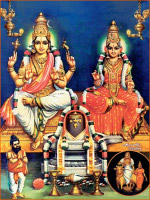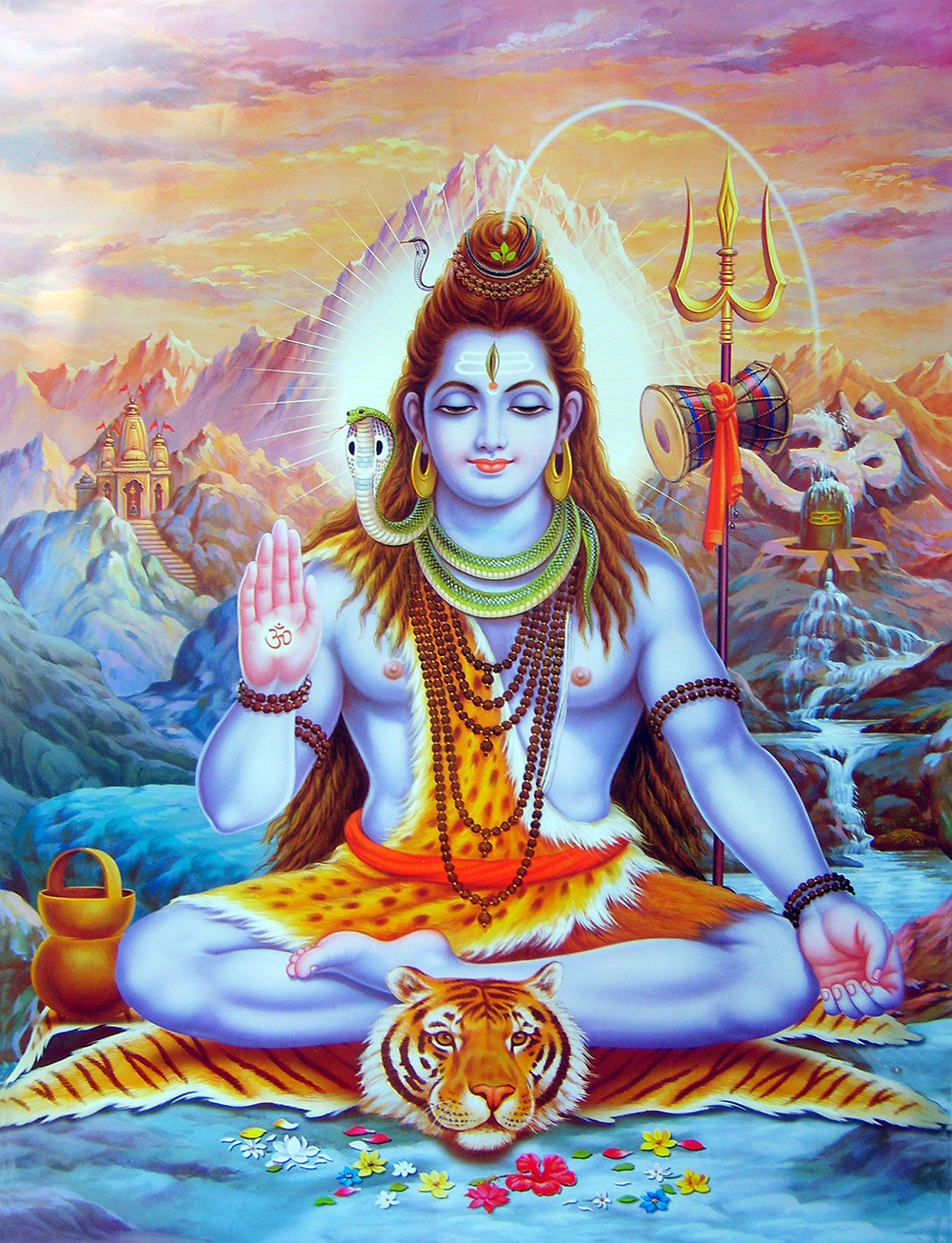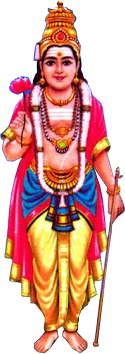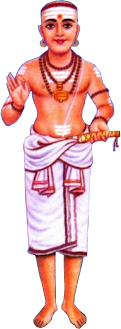
Story of King Chitrabhanu
Reward of Kingship for Doing Unconscious Shiva Pooja
There are various Karna Parampara story connected with Mahashivarathri. We will present here the few famous stories. Among them is the story of Kin Chitrabhanu, celestial marriage of Shakthi and Shivam, Parvati's penance, the legend of Ganga, The legend of Shiva LingaKING CHITHRABHANU’S PREVIOUS BIRTH
The story of King Chirabhanu is narrated by Sri Bhishma in the Shanti Parva of Mahabharatha, detailing how he was given birth as a King for his fast during Shivarathri. King Chithrabhanu belongs to Ishvaku dynasty - whose lineage Lord Rama was borne. Chithrabhanu was dutifully observing a fast with his wife on the Maha Shivarathri day. The great sage Ashtavakra came to the court of the king. It was a Mahashivarathri day. The sage asked the King why he was observing a fast on this day. The King explained that he was blessed with remembering about his previous birth.The King narrated that in his previous Janma he was a hunter and his name was Sushwara. He was hunting and killing birds and animals, that too in Varanasi. One day on his routine, he was hunting for animals deep in to the forest, darkness fell and he was caught in the forest. He perched on a tree for shelter. It happened to be a Beal (Vilvam) tree. He killed a deer and hung upside down in the tree. He had no time to take it home, hunger and thirst struck him, he was kept awake throughout night as he was afraid sleeping on the tree would make him fall on the ground and he will become a prey to wild animals. In order not to sleep, he plugged the leaves of tree and put it on the ground. He thought of his family and cried as they too would be starving. Next day he returned home, bought food and gave some portion to strangers before consuming it. Years passed and his last day on earth came. Lord Shiva's two messengers came to take his soul away to the abode of Lord Shiva. Then he learnt that he earned this merit because of his pooja done unknowingly during Shivarathri day. The tears he shed thinking about his family's plight fell on Shivalingam down the tree. The leaves he dropped fell on the Shivalingam, he could not eat food as he got held up in forest became a pure fast, next day he distributed food to someone before consuming, thus breaking the fast in tradition. This earned him a berth in heaven and after sufficient delightful life at the abode of Lord, he was borne again as King Chitrabhanu.
MARRIAGE OF SHIVA AND SHAKTI
The legend of marriage of Shiva and Shakti is one the most important legends related to the festival of Mahashivaratri. The story tells us how Lord Shiva got married a second time to Shakti, his divine consort. According to legend of Shiva and Shakti, the day Lord Shiva got married to Parvati is celebrated as Shivaratri - the Night of Lord Shiva.
THE LEGEND
Legend goes that once Lord Shiva and his wife Sati or Shakti were returning from sage Agastya’s ashram after listening to Ram Katha or story of Ram. On their way through a forest, Shiva saw Lord Rama searching for his wife Sita who had been kidnapped by Ravana, the King of Lanka. Lord Shiva bowed his head in reverence to Lord Rama. Sati was surprised by Lord Shiva’s behavior and inquired why he was paying obeisance to a mere mortal. Shiva informed Sati that Rama was an incarnation of Lord Vishnu. Sati, however, was not satisfied with the reply and Lord asked her to go and verify the truth for herself.Using her power to change forms, Sati took the form of Sita appeared before Rama. Lord Rama immediately recognized the true identity of the Goddess and asked, "Devi, why are you alone, where's Shiva?" At this, Sati realized the truth about Lord Ram. But, Sita was like a mother to Lord Shiva and since Sati took the form of Sita her status had changed. From that time, Shiva detached himself from her as a wife. Sati was sad with the change of attitude of Lord Shiva but she stayed on at Mount Kailash, the abode of Lord Shiva.
Later, Sati’s father Daksha organised a yagna, but did not invite Sati or Shiva as he had an altercation with Shiva in the court of Brahma. But, Sati who wanted to attend the Yagna, went even though Lord Shiva did not appreciate the idea. To hre great anguish, Daksha ignored her presence and did not even offer Prasad for Shiva. Sati felt humiliated and was struck with profound grief. She jumped into the Yagna fire and immolated herself.
Lord Shiva became extremely furious when he heard the news of Sati’s immolation. Carrying the body of Sati, Shiva began to perform Rudra Tandava or the dance of destruction and wiped out the kingdom of Daksha. Everybody was terrified as Shiva’s Tandava had the power to destroy the entire universe. In order to calm Lord Shiva, Vishnu severed Sati's body into 12 pieces and threw them on earth. It is said that wherever the pieces of Shakti’s body fell, there emerged a Shakti Peetha, including the Kamaroopa Kamakhya in Assam and the Vindhyavasini in UP.
Lord Siva was now alone undertook rigorous penance and retired to the Himalayas. Sati took a re-birth as Parvati in the family of God Himalaya. She performed penance to break Shiva’s meditation and win his attention. It is said that Parvati, who found it hard to break Shiva’s meditation seeked help of Kamadeva - the God of Love and Passion. Kaamadeva asked Parvati to dance in front of Shiva. When Parvati danced, Kaamadeva shot his arrow of passion at Shiva breaking his penance. Shiva became extremely infuriated and opening his third eye that reduced Kaamadeva to ashes. It was only after Kamadeva’s wife Rati’s pleading that Lord Shiva agreed to revive Kaamadeva. Later, Parvati undertook severe penance to win over Shiva. Through her devotion and persuasion by sages devas, Parvati, also known as Uma, was finally able to lure Shiva into marriage and away from asceticism. Their marriage was solemnized a day before Amavasya in the month of Phalgun. This day of union of God Shiva and Parvati is celebrated as Mahashivratri every year.
ANOTHER VERSION OF THE LEGEND
 According to another version of the legend, Goddess Parvati performed tapas and prayers on the auspicious moonless night of Shivaratri to ward off any evil that may befall her husband. Since then, womenfolk began the custom of praying for the well being of their husbands and sons on Shivaratri day. Unmarried women pray for a husband like Shiva, who is considered to be the ideal husband.
According to another version of the legend, Goddess Parvati performed tapas and prayers on the auspicious moonless night of Shivaratri to ward off any evil that may befall her husband. Since then, womenfolk began the custom of praying for the well being of their husbands and sons on Shivaratri day. Unmarried women pray for a husband like Shiva, who is considered to be the ideal husband.
Once Lord Vishnu and Lord Bramha argued over each other’s prowess. However, Lord Shiva challenged both of them. He appeared as a flaming Linga and challenged the duo to measure the gigantic Linga (phallic symbol of Lord Shiva). Lord Bramha, who took the form of a swan, and Lord Vishnu who became a boar and went to Netherland, were both unable to measure the Shivlinga. Then Lord Shiva came out of the Linga and declared himself the most powerful. Maha Shivratri therefore means the grand night of Shiva. The devotees of Shiva fast during this day and pray to the lord throughout the night. This legend goes to prove the supremacy of Mahadev over other Hindu Gods.
King Daksha, opposed Sati’s marriage with Shiva. At a Yagnya (holy sacrifice) the king ignored Shiva’s presence and thereby insulted the latter publicly. Sati was so angered by this that she jumped into the sacrificial fire and ended her life. Lord Shiva unleashed his fury at the death of his wife by performing the violent dance, Taandav. He wiped out Daksha’s kingdom, undertook rigorous penance and retired to the Himalayas. The Gods, who feared that the severity of Shiva’s penance might bring an end to the world, revived Sati in the new avatar of Parvati. Shiva-Parvati married and this reunion is celebrated on Maha Shivratri.
SCIENCE WORSHIP OF LORD SHIVA ON THIS DAY
1. EMITTING WAVES OF KNOWLEDGE, DEVOTION AND RENUNCIATION
Predominantly ‘sattva’ waves of knowledge, ‘raja’ waves of devotion and ‘tama’ waves of Renunciation (Vairagya) are emitted by the ‘Shivpindi’. During Mahashivratri, the emission increases by 30 percent.
2. EMISSION OF SUBTLE VIBRATIONS OF UNIVERSE, BLISS AND PEACE
The ‘Shivalingam’ emits subtle vibrations of world, bliss and peace. During Mahashivratri, the emission increases by 25 percent. This helps purify the subtle-body of one who worships the Shivalingam on this day. The ‘sun’ or the ‘moon’ channels in the body get activated as per necessity. The capacity to absorb the sattvaguna (positive attitude) and World also increases. Due to the presence of the unmanifest Shiva principle in the Shivalingam and the vibrations of peace is emitted, the Shivalinga remains cool and the mind too experiences peace. Worship of Shivalingam with devotion, activates the dormant Shiva principle. An offering of puffed rice and milk reaches Lord Shiva in the subtle form.
3. RECEIVING THE 'SAVIOUR OR DESTROYER PHILOSPHY (ELEMENT) AS REQUIRED
There is a confluence of the manifest and the unmanifest elements along with the ‘tarak and marak tatva’ in the Shivalingam. (Tarak = Saviour; Marak = Destroyer). That is how worshipers receive the required element. The temperature of the Shivalingam increases due to the emission of the Marak Tatva and there one experiences bliss. Similarly, when the Tarak Tatva (Positive energy) is emitted, the temperature drops and one experiences peace and bliss.
BILVAPATRA (BAEL LEAVES)
Vilvam contains 2% Shiva philosophy. By offering Bilva leaves to the Shivalingam on Mahashivratri or any other day, the manifest Shiva Tatva near the stalk of the Bilvapatra gets activated. Due to this, waves of Chaitanya as well as Shiva tatva are emitted by the Bilvapatra. The Bilvapatra attracts 20% of the Shiva tatva present in the Shivalingam towards itself. By immersing this Bilvapatra in water or by placing it in grains, the Shiva tatva present in the Bilvapatra is transmitted to them. The Shiva Tatva in the Bilvapatra is activated to a larger extent on Mondays when it transmits 10% of the Shiva Tatva and Satvikta. On other days only 1% of the Shiva Tatva is activated in the Bilvapatra.
CHANTING ON MAHASHIVARATRI ‘OM NAMAH SHIVAYA’
OM represents an unmanifest state beyond the 3 gunas (elements of sattva, raja & tama). We bow to Lord Shiva, from whom Om was created.
1. The word Shiva has been derived by reversing the letters of the word Vash. Vash means to Enlighten; thus the one who enlightens is Shiva. He remains radiant and also illuminates the universe.
2. He is the auspicious and prosperity-bestowing principle.









